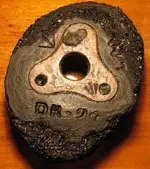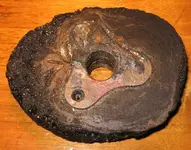This is interesting:
The seriously decayed state of Block Mills, listed Grade I, in Portsmouth dockyard was horribly apparent when delegates to the Dockyard Historical Society's conference visited the site on 30 April.
Block Mills is the site of a world first: the first steam powered mass production factory for the hundreds of thousands of pulley blocks for ships' rigging and gun carriages needed by the army and navy by the beginning of the nineteenth century. Toward the end of the Napoleonic period 922 pulley blocks were required to equip a standard 74-gun ship; the 27 British ships of the line that confronted the combined French and Spanish fleet at the Battle of Trafalgar would have had about 25,000 blocks in their rigging. 100,000 blocks a year were needed. The Taylor family of Southampton had been one of the largest suppliers of craftsmen-made blocks over three generations, but could not keep up with demand. Marc Isambard Brunel (1769-1849) who had been Chief Engineer of the City of New York had considered how blocks might be manufactured in quantity by machines.
Having failed to persuade Taylors to mechanise, Brunel convinced Sir Samuel Bentham (1757-1831), Inspector General of Naval Works, who had himself studied the application of machinery to woodworking in a small shipyard at Redbridge in Southampton, to set up the navy's own manufactory at Portsmouth dockyard to which the steam engine and machinery from Southampton were transferred. Brunel's machinery called for superior workmanship, and in Henry Maudslay (1771-1831) he found the brilliant engineer to make his precision machine tools in metal to give accuracy and rigidity. One set of machines manufactured the shell of the block from solid pieces of elm; another produced the lignum vitae sheave or pulley wheel. The series of machines they developed performed a sequence of some twenty separate operations to ensure a steady flow of components from raw materials to standardised assembly – a system for mass production which ran well for over a hundred and fifty years.
The first steam engine in dockyards was introduced in 1799 by the first Inspector-General of Naval Works from 1795, Sir Samuel Bentham. It was used to pump water out of dry docks at Portsmouth dockyard – a momentous step – since until then every dockyard had relied on muscle power alone. Horses had been used to transport timber and stores, operate gins for dock pumping, and, from the 1770s, to provide power for certain processes in the roperies. But once steam engines were given rotary motion and could be harnessed to machine tools they became practical and economic propositions. A rectangular stone structure surmounted by a heavy timber frame inside the southern range of Block Mills marks the site of this early pumping machinery. Within the same range, a beam engine house with a horizontal iron frame supporting the beam trunnions also survives. It is probably the second steam engine for which Bentham commissioned Boulton and Watt to help with dock-pumping and to power the new machinery for the mass production of pulley blocks.
Today, pools of water stand in the main linking hall where parts of the overhead drive are still in situ. The enormous beams supporting the timber flooring of the north block has partly rotted away to a pile of wet shreds, and the precious Maudslay machines upstairs have had to be covered with polythene sheet to protect them from leaks in different areas of the roof. The drains are backing up, causing more damage, and the wall of the north wing is bowing out, perhaps because of the spreading of the Belfast roof trusses. On the top floor of the south wing are long standing wet patches, green with mould. It ought to be a matter of public shame that the building at the very top of English Heritage's Buildings at Risk list - at Extreme Risk - is publicly owned. We heard at the conference that there was a proposal for Block Mills to be taken into Guardianship some years ago - which failed because the government would not spend £15,000 bringing it into good repair. If that had happened Block Mills would at least have been kept weather-tight. We will be adding our voices to those pressing the Second Sea Lord to take urgent action on repairs, and also to open up proposals for its future to public debate







